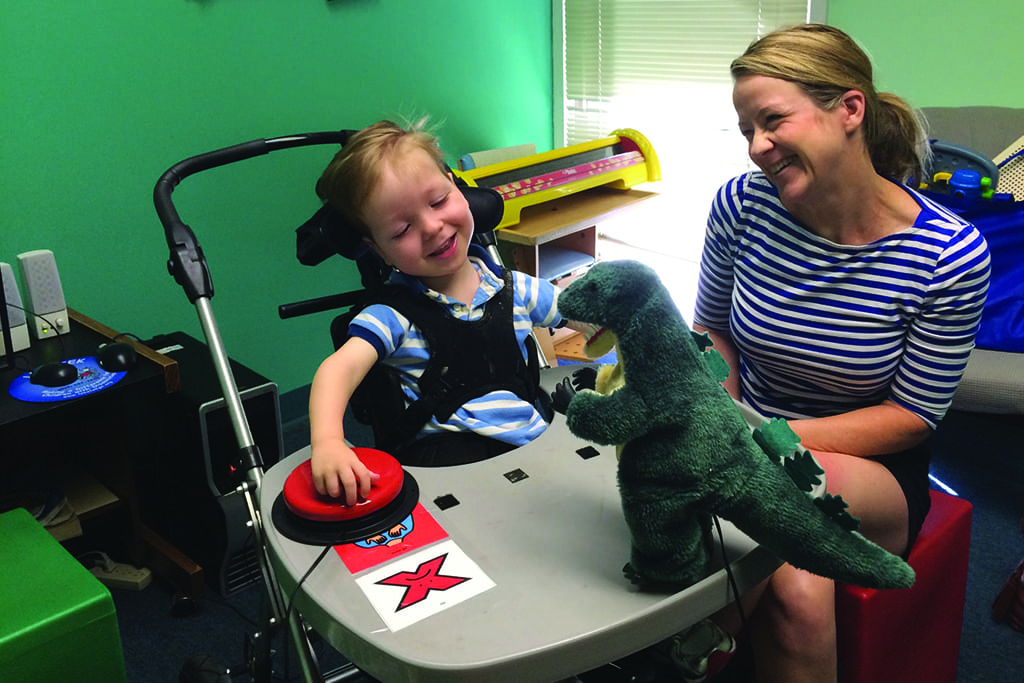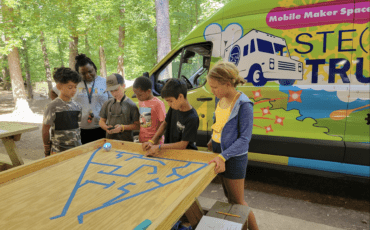Technology Makes Life Easier for Kids with Special Needs

Lekotek of Georgia
New gadgets, phones and apps make our lives easier. For kids with special needs, though, technology can be the difference between participating fully and being left out.
With portable electronic devices, kids with disabilities are finding it easier to fit right in using assistive technology to communicate, socialize and learn.
Assistive technology has another advantage, too, the devices can promote learning by engaging a child in play.
“All the bells and whistles help facilitate learning and developing skills, more so than a wooden toy, because a child gets immediate positive reinforcement,” says Helene Prokesch, executive director of Lekotek of Georgia.
These simple guidelines can help parents identify the best device or program for their child.
Table of Contents
Know Your Child’s Needs
Think about your child’s challenges and strengths. What can he do or not do in comparison with his peers? What would he like to do that he can’t do now? For instance, some students have difficulty reading print, but are perfectly able to understand information when it’s delivered verbally.
For some children, it’s important to “fit in,” and they’ll be reluctant to use any device that draws attention to them. If a particular piece of technology has already caught your child’s attention, what’s appealing about it? Ask how you think it might help him.
Do a Little Research
Nonprofit organizations provide online support and disability-specific information. Often, you’ll find assistive technology suggestions, product reviews, updates on current research and parent support groups.
Lekotek of Georgia provides a wide range of support to families and children with disabilities by providing accessible play, adapted toys, technology, information and resources. Lekotek primarily works with kids through age 8, with computer services available for teens and young adults. Their website offers a list of resources for assistive technology, and staff can assist parents in choosing items based on the child’s needs. Call Lekotek at 404-633-3430 for more information.
Seek Professional Advice
Therapists, teachers and doctors who work with your child will have suggestions. Your child’s special education teacher will know about devices that assist with academic challenges. And the speech/language pathologist can make recommendations regarding communication tools.
Try Different Technologies
Even within a specific disability group, a device might work well for one person but not another. Kids have different physical, cognitive and social-emotional needs.
Your child’s school may have assistive technologies available to try, and lending libraries for assistive devices are available in every state.
In Georgia, a network coordinated by Tools for Life at Georgia Tech, which includes organizations throughout the state, maintains a lending library that contains several hundred assistive technology devices, from vision and hearing aids to all types of computer technologies.
Tools for Life also can help families determine what assistive technology might work best for their special needs kid or adult, provide demonstrations of those technologies and direct families to the closest lending organization near their home. These services are free; a full evaluation of a child’s needs comes with a fee.
Tech researchers are currently evaluating the effectiveness of assistive technology in a study involving young adults.
“What we know is that young adults are more successful at living independently and holding a job if they have access to assistive technology in school,” says Ben Satterfield, a researcher with Tools for Life. “We’re not sure why that is. It may be they develop a sense of empowerment, when they realize ‘I can read” or “I can write, if I can use this tool.’ If they can develop more independence with the supports they have in school, they do better when they leave school. Parents also have a critical role to play.”
Tools for Life is developing a database to publish online to help families know what types of technology are available for lending, how it works and how it might help their child or adult. For information about the lending program call 404-894-0541.
Technology at School
If your child is on an Individualized Education Program, his school should support use of technology when there is an educational need. Federal special education law defines assistive technology (AT) as: “Any item, piece of equipment or product system … that is used to increase, maintain or improve the functional capabilities of children with disabilities.” That’s a bit of a mouthful, but it means AT can include everything from low-tech devices (like a pencil grip), to high-tech computers and accessories (like a refreshable-display braille keyboard). Federal law also requires the team to consider AT needs when developing a child’s IEP.
When the team decides that AT is required for educational purposes, the details should be written into your child’s IEP.
In most cases, your school district is responsible for funding the purchase, maintenance, and replacement of any assistive technology written into the IEP. That also means the district owns the equipment. Usually (but not always), your child will be able to take equipment home during off-school hours and breaks. But if you move out-of-district, your child will not be able to take the AT with him; it stays with the district for use by another child.
Cool Stuff
Here are just a few samples of recent tech innovations:
Livescribe Echo Smartpen. This pen has a microphone, camera and speaker; it enables those with a visual impairment or learning disability to take audio notes, record lectures and store/share docs digitally.
Talkitt: This Is My Voice. This enables people with severe speech disabilities to communicate by converting the user’s vocal patterns into recognizable verbal output.
Sesame Enable. This touch-free app enables the user to operate a smartphone with head movements.
Kurzweil 3000. This text-to-speech software reads digital and print formats aloud.
Purchasing AT
Assistive technology can be a big investment. Following are resources that can help keep costs down.
Resources in Georgia. Georgia Tools for Life provides access to assistive technology through evaluation, lending libraries and education. Friends of Disabled Adults and Children (FODAC) provides refurbished equipment and services, including assistive technology, to adults and children with disabilities.
Online marketplaces. Pre-owned equipment is bought and sold by private parties.
Health insurance, Medicare or Medicaid. They may partially or fully cover cost if the equipment is medically necessary.
– Ashley Talmadge







